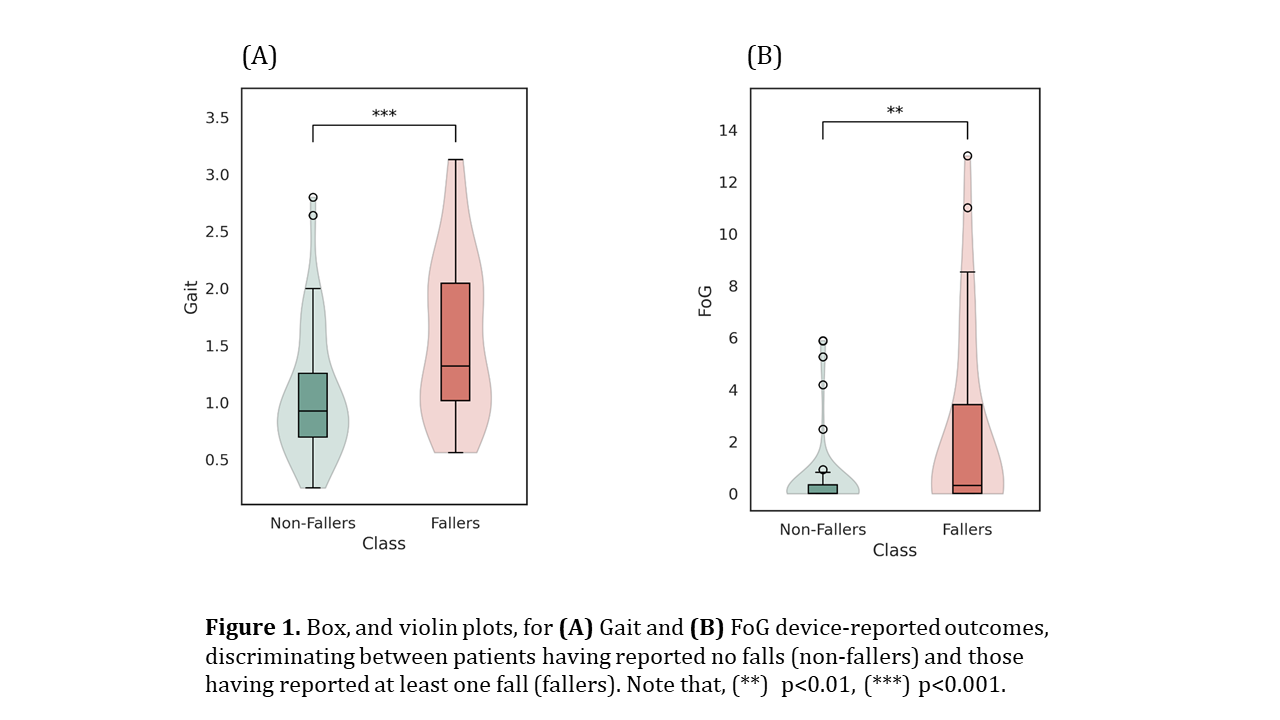Category: Technology
Objective: This work presents an analysis of real-world, device-reported outcomes from patients with Parkinson’s disease (PD) in Greece. A total of 82 patients were included in the analysis to investigate the potential for fall risk identification based on gait and balance indicators as produced by a telemonitoring system.
Background: Hospitalization rates are a growing concern for healthcare systems, and falls are a significant contributor to this issue, leading to frequent and extended stays [1]. During the progression of idiopathic PD, falls occur, with a higher frequency than in age-matched cohorts, and often resulting in more severe, even life-threatening injuries [2], [3]. Therefore, the development of methods for identifying fall risk and predicting falls through machine learning, holds promise for preventing falls, alleviating the strain on healthcare systems and enhancing patients’ quality of life [4].
Method: Data were collected from 82 patients in Greece that had used a telemonitoring system (the PDMonitor). Those included: (1) two device-reported gait and balance indicators, namely gait impairment (denoted as Gait) and freezing of gait (denoted as FoG), as well as (2) patient-reported information (questionnaires) for the identification of fallers, obtained through the device manufacturer’s post market surveillance procedure. The device-reported outcomes were divided into two groups, outcomes for: (1) patients who reported at least one fall (31 patients), (2) patients who reported no falls (51 patients). A T-test was then used to compare whether there is a significant statistical difference between the two patient groups for each outcome.
Results: The device measured higher values of both Gait and FoG for the fallers group, compared to the non-fallers group. As shown in Figure 1, the differences in both device-reported outcomes were found to be statistically significant, with p-values of 0.002 and 0.0004 for Gait and FoG, respectively.
Conclusion: Early indicators of increased fall risk could be of great importance for timely fall prevention strategies. In this study, digital indicators from a home telemonitoring system (Gait and FoG), exhibited notably higher values in patients who had reported falls. As a result, objective identification of gait impairment and freezing of gait recorded at home, longitudinally, could provide an indication of higher fall risk and enable timely fall prevention interventions.
Figure 1
References: [1] A. Van Bladel, N. Herssens, K. Bouche, D. Cambier, L. Maes, and N. Lefeber, “Proportion of falls reported in persons with Parkinson’s disease: A meta-analysis,” Clin. Rehabil., vol. 37, no. 9, pp. 1260–1277, Sep. 2023, doi: 10.1177/02692155231158565.
[2] N. E. Allen, A. K. Schwarzel, and C. G. Canning, “Recurrent Falls in Parkinson’s Disease: A Systematic Review,” Park. Dis., vol. 2013, p. e906274, Mar. 2013, doi: 10.1155/2013/906274.
[3] A. F. Ambrose, G. Paul, and J. M. Hausdorff, “Risk factors for falls among older adults: A review of the literature,” Maturitas, vol. 75, no. 1, pp. 51–61, May 2013, doi: 10.1016/j.maturitas.2013.02.009.
[4] I. Bargiotas et al., “Preventing falls: the use of machine learning for the prediction of future falls in individuals without history of fall,” J. Neurol., vol. 270, no. 2, pp. 618–631, Feb. 2023, doi: 10.1007/s00415-022-11251-3.
To cite this abstract in AMA style:
F. Kanellos, G. Rigas, A. Ntanis, N. Kostikis, S. Kontaxis, L. Liouta, C. Tsitsou, S. Konitsiotis. Identification of Fall Risk in Patients with Parkinson’s Disease Through Telemonitoring [abstract]. Mov Disord. 2024; 39 (suppl 1). https://www.mdsabstracts.org/abstract/identification-of-fall-risk-in-patients-with-parkinsons-disease-through-telemonitoring/. Accessed December 23, 2025.« Back to 2024 International Congress
MDS Abstracts - https://www.mdsabstracts.org/abstract/identification-of-fall-risk-in-patients-with-parkinsons-disease-through-telemonitoring/

